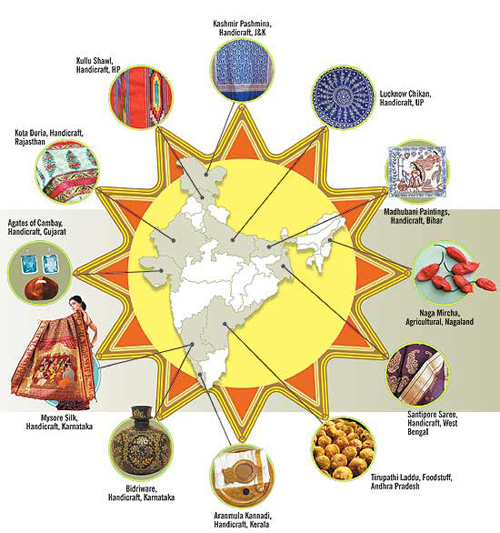GI TAG & ITS BENEFITS
GI TAG & ITS BENEFITS

What : A geographical indication (GI) is a name or sign used on certain products which corresponds to a specific geographical location or origin (e.g., a town, region, or country).
About
- India, as a member of the World Trade Organization (WTO), enacted the Geographical Indications of Goods (Registration and Protection) Act, 1999 has come into force with effect from 15 September 2003.
- GIs have been defined under Article 22 (1) of the WTO Agreement on Trade-Related Aspects of Intellectual Property Rights (TRIPS) Agreement as: “Indications which identify a good as originating in the territory of a member, or a region or a locality in that territory, where a given quality, reputation or characteristic of the good is essentially attributable to its geographic origin.”
Who issues GI tag in India: This tag is valid for a period of 10 years following which it can be renewed. Recently the Union Minister of Commerce and Industry has launched the logo and tagline for the Geographical Indications (GI) of India.
Which state has highest GI tag: Karnataka has the highest number of GI-tagged products. However, when geographical area is factored in, Kerala has the highest.
Benefits of GI Tag
- Encourages the preservation of biodiversity, local know-how and natural resources. Automatically resolve the three fraught India issues of poor pay for talent, low female participation in the labour force, and urban migration.
- Convert talent into entrepreneurship with gig workers, and create a “passion” economy, that is, a new way for individuals to monetise their skills and scale their businesses exponentially. It removes the hurdles associated with freelance work to earn a regular income from a source other than an employer.
- Labour-intensive nature of GI offers the best solution to boosting the employment-to-population ratio in India, an abysmal 43 per cent compared with the 55 per cent global average. Monetising artisanal work done at home will increase India’s low female labour force participation rate, which at 21 per cent in 2019 was half the 47 per cent global average.
- Offers solutions to reverse urban migration and conserve India’s ancient crafts, culture and food. A rejuvenation of MSMEs, which account for 31 per cent of India’s GDP and 45 per cent of exports, will follow. An estimated 55.80 million MSMEs employ close to 130 million people; of this, 14 per cent are women-led enterprises and 59.5 per cent are rural. Another revenue-earner, GI tourism, is typically a by-product of a strong GI ecosystem.
- Address the challenges of capacity-building, formal or easy access to credit, forming marketing linkages, research and development, product innovation and competitiveness in both domestic and international markets. The groundwork for MSME access to formal credit has already been done with the new Account Aggregator data-sharing framework.
CONCLUSION
The Indian GI economy can be a platform for India to showcase to the world a model for ethical capitalism, social entrepreneurship, de-urbanisation, and bringing women to the workforce, on the back of a robust digital system. It encompasses the concept of trusteeship, as advocated by Mahatma Gandhi and more recently, by Prime Minister Narendra Modi at the UN. It is truly Made in India

